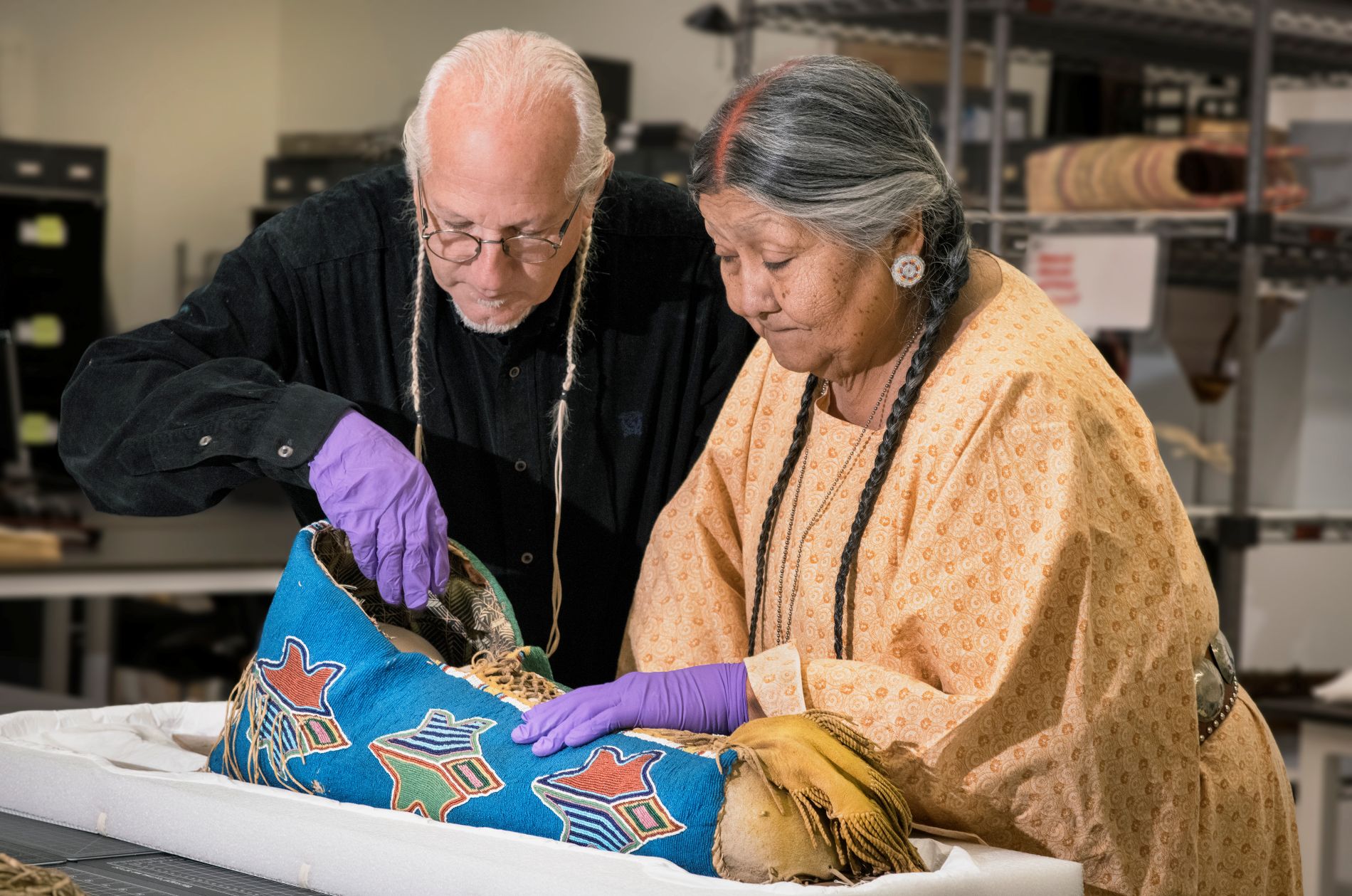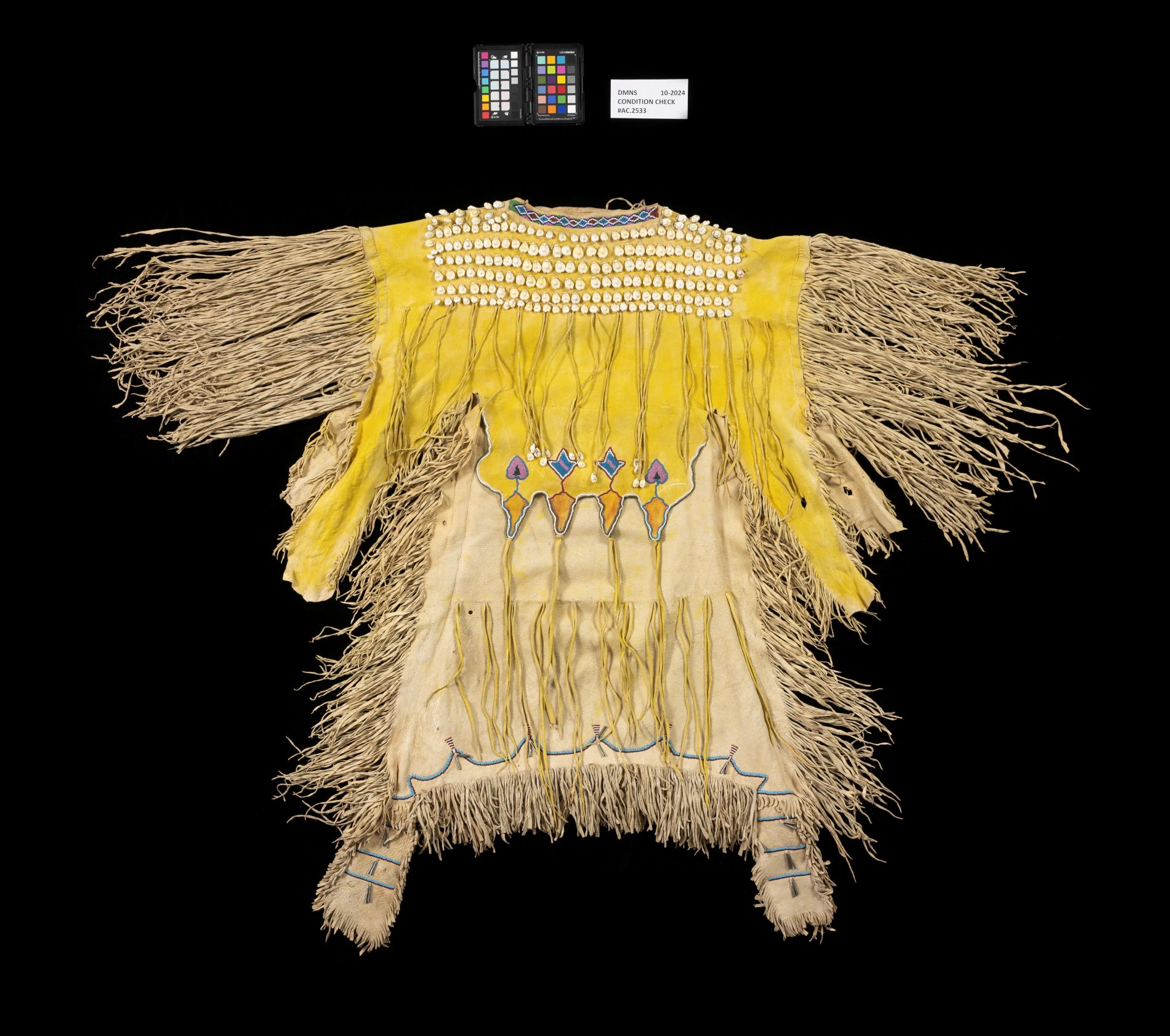CATALYST
DENVER MUSEUM OF NATURE & SCIENCE ONLINE MAGAZINE
The Museum Beadwork Collection Travels to Oklahoma
Building a New Model of Collaboration Between Tribal Governments and Cultural Institutions

Examination of Denver Museum of Nature & Science beadwork material by Carl Jennings and Vanessa Paukeigope Jennings from the Kiowa tribe in Oklahoma. (Photo/ Rick Wicker)
A group of high school students from Carnegie High School in Oklahoma huddles around a table of Kiowa beadwork. Little ones from the Kiowa Head Start program shout out their favorite colors as they look at the intricate beaded regalia made by their ancestors. Historical collections of Kiowa beadwork continue to be relevant to communities today, and the Avenir Conservation Center and the Anthropology Department at the Denver Museum of Nature & Science have spent the last three years working with the Kiowa Tribe to make the Museum’s collection accessible to community members in Oklahoma.
The Southern Plains Beadwork Project has been many years in the making. Originally conceived in 2016 as a publication highlighting the Museum’s premier collection of Southern Plains Beadwork, the project has evolved into a new model of collaboration with tribal government and cultural institutions.
While the Museum routinely hosts consultations with community members about collections, these require tribal representatives to travel to Denver. There are, however, many knowledge keepers within their respective communities who cannot always make the trip but have important insights to share with the Museum and their relatives. The Southern Plains Beadwork project seeks to address this gap, and to identify ways to work with community in community. In 2022, anthropology and conservation staff hosted community meetings with Cheyenne, Arapaho and Kiowa tribal citizens in Concho, Watonga, Hammon, Oklahoma City, Carnegie and Anadarko Oklahoma.

Community participants of Kiowa Tribe of Oklahoma handle and closely examine belongings in a discussion on the designs, methods of construction and traditional care practices at First Americans Museum in Oklahoma City. (Photo/ Casey Mallinckrodt)
During these meetings, Museum staff shared images of the collection as well as its history at the Museum and then asked attendees if it would be appropriate to develop a project related to these collection areas. If so, what would tribal citizens like to see included in this project? Based on these conversations, the Museum partnered with First Americans Museum in Oklahoma City, which serves as a host site for the Museum’s collections. In partnership with the appropriate tribal governments, the Denver Museum of Nature & Science hosted our community partners to support their visit to Denver and selection of 45 belongings to travel to First Americans Museum in preparation for listening sessions with “beadworkers” and knowledge keepers.
During these sharing sessions participants are encouraged to handle and closely examine the belongings and to discuss the designs, methods of construction and traditional care practices. Historically, museums have restricted or limited non-staff handling of collection items, but the Beadwork Project prioritizes access which includes trust for the community members.
The discussions provided information about these collections while giving the community members time together to exchange and generate new ideas. And each person emphasized the care and love the makers had for the person who would wear the dress, the leggings, the moccasins and they conveyed that the makers and wearers remain present through these belongings.

Image of back of Kiowa girl's dress from Denver Museum of Nature & Science Anthropology Collections. (Photo/ Rick Wicker)
In the next phase of this project, Museum staff took collections items to the Kiowa tribal complex so tribal citizens could view the collection, ask questions, and share information. The Denver Museum of Nature & Science also sponsored two beadwork workshops led by Kiowa “beadworkers.” The instructors taught introductory moccasin and men’s bag classes. While men’s bags were very popular accessories during the late 19th and early 20th centuries, they are less common today and the workshops provided instructors the opportunity to teach emerging beadwork artists how to revive an important historical component of men’s attire. The Avenir Conservation Center is committed to centering community values and practices in our work. In this project, we prioritize learning directly from communities about how best to care for their belongings—even when that challenges our well-intended assumptions and professional “best practices.”
We initially expected to collaborate with experienced community beadworkers to carry out necessary repairs. However, we have come to understand that the lives of these garments — moccasins, cradleboards, leggings — are deeply embedded in the intentions of the makers and the lived experiences of the wearers. In many cases, conservation treatment could disrupt those layered histories.
The guidance we’ve received most often is to prevent further deterioration, but otherwise, to let the objects remain as they are.
Conservation is inherently cautious, grounded in rigorous ethical standards. This project underscores the profound importance — and consequences — of shifting conservation work into the community, both physically and ethically.
This project will culminate in a community-curated exhibition of the Denver Museum of Nature & Science collection items at the First Americans Museum. The Avenir Conservation Center extends its deepest thanks to our partner institutions Texas Tech University and First Americans Museums, as well as the Kiowa Tribe and Cheyenne and Arapaho tribe governments for their incredible partnership.
Summer 2025
In This Edition
-
Hunting for the Last Cretaceous Ecosystems of Peru
Museum Paleontologists Climb the Andes to Crack the Fossil Code
-
The Story Behind Nature Play’s Public Art Installations
Meet the Artists Helping to Shape a Unique Creative Play Experience in City Park
-
Museum Launches a New Way to Discover our Digital Collections
You Can Now Download Material Directly from Science Collections!
-
What DNA Can Tell Us About Our World
A Behind the Science Conversation with the Scientists in our Genomics Lab
-
Radiant Science! The Museum's Fluorescent Rocks
How the Museum is Assembling a Glow-in-the-Dark Mineral Display
-
Finding Direction in Our Current State of Affairs
The Institute of Science & Policy Provides Tools, Resources for Critical Thinking
-
The Museum Beadwork Collection Travels to Oklahoma
Building a New Model of Collaboration Between Tribal Governments and Cultural Institutions
Share this:
